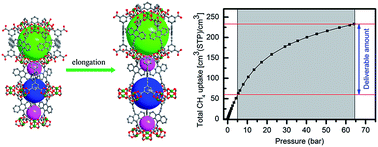A porous metal–organic framework with an elongated anthracene derivative exhibiting a high working capacity for the storage of methane†
Abstract
We have developed a new porous metal–organic framework (MOF) (UTSA-80) with an elongated anthracene derivative as a linker. The activated UTSA-80a has a pore volume of 1.03 cm3 g−1 and a gravimetric Brunauer–Emmett–Teller surface area of ca. 2280 m2 g−1, higher than those of PCN-14. The volumetric methane storage capacity of UTSA-80a at 35 bar and 298 K is 192 cm3 (STP) cm−3, which makes it one of the few porous MOFs with a storage capacity >190 cm3 (STP) cm−3 at 35 bar. The volumetric uptake of methane by UTSA-80a reaches 233 cm3 (STP) cm−3 at room temperature and 65 bar; this is 88.6% of the new volumetric target of the US Department of Energy if the packing density loss is ignored. This capacity is comparable with that of PCN-14. However, as a result of the lower methane uptake of UTSA-80a at 5 bar, it has a much higher methane storage working capacity (deliverable amount of methane between 65 and 5 bar) of 174 cm3 (STP) cm−3 compared with PCN-14 [157–160 cm3 (STP) cm−3]. This value is slightly lower than the 190 cm3 (STP) cm−3 achieved by HKUST-1, suggesting that it is a promising material for methane storage in transport applications. Such an exceptionally high working capacity can probably be attributed to the elongated anthracene derivative used as a linker within UTSA-80a, which adjusts the pore sizes/cages and interactions with the methane molecules to optimize the methane working capacity.


 Please wait while we load your content...
Please wait while we load your content...